| Poinsettia is famous due mostly to exceeding marketing for its usage as a containerized floral plant sold near Christmas time. Few --if any-- edible plants are burdened under such a widespread misinformed public belief to the contrary; most people believe incorrectly that the plants are poisonous, period. Their sap, to sensitive people's skin, is mildly so. But read on and learn more. |
| Native to mountains in the west of Mexico, and in Guatemala, the wild Poinsettia grows as a slender, lanky and brittle shrub or small tree, recorded as tall as 26 feet / 8m. Several close relatives exist, including Euphorbia cornastra and Euphorbia strigosa, but the common Poinsettia Euphorbia pulcherrima, is the species (and its hybrids) that has been cultivated in the USA, Europe and elsewhere around the world since at least the 1820s. |
| There are hundreds and hundreds of cultivars now. Thousands of acres of greenhouses produce the plants for sale. This being commonplace knowledge, I offer for you now some lesser known facts. Other common names include: Christmas Star, Christmas Plant or Christmas Flower. Painted Leaf. Lobster Plant. Mexican Flameleaf. Spanish: Flor de Pascua. |
| Poinsettia is grown by most people as a houseplant. But in tropical, subtropical, and some warm-temperate areas, it flourishes outside, and then becomes large. It can be evergreen or deciduous, depending on the climate. |
| The genus Euphorbia is very large, with over 1,000 species; at least 40 of them have been recorded as eaten by people. On the other hand, the white sap of many, likely most, Euphorbia species, is dangerous to human skin, especially to eyes. Presumably the sap is a defense against herbivory. Most Euphorbia species that are eaten by people, are cooked, and that "zaps" the sap. |
| Compared to many vegetables, edible members of the Spurge Family are high in protein. Some examples: Acalypha spp. 13.78 - 18.15%, Cnidoscolus 2.71 - 8.25%, Codiæum variegatum ca. 5%, Manihot esculenta 2.92 - 8.64%. The closely related Sauropus is 6 - 10% protein. Not only are the leaves nutritious, but each of the above 5 genera that I have eaten, was pleasing in texture and taste. |
| The problem with eating Poinsettia is not the species per se, but the way the plants are processed and made available to most people. Wholesale growers drench the plants with insecticides, fungicides, and growth retardants (such as Paclobutrazol = Bonzi®) such as are not registered as safe for use on edible plant crops. Therefore, unless an individual has access to a Poinsettia plant several years old, grown organically . . . then treating Poinsettia plants as poisonous is prudent. And if one does have access to chemical-free Poinsettia plants, then one should limit consumption to the tender young shoots and leaves, cooked. The sap on bare skin, or even brushing the leaves, can injure people whose skin is sensitive. |
The first reference to the edibility of Poinsettia that I know is from 1931. I have not discovered that it has been eaten in Mexico, though it is used medicinally there.
|
Vegetables of the Dutch E Indies by J.J. Ochse 1931: "Two varieties exist, differing in the colour of the bracts which in the first form are splendidly red, in the second colourless or yellowish-green. The variety with the bright red bracts is, of course, the one most used for ornamental purposes. Yet another form is known in which the bracts remain green during a long time and only after anthesis become here and there more or less intensely red. This form is mostly used for living fences and is yet more frequently used as a vegetable than the red form. The young tops of the branchlets, the inflorescences and the young leaves, especially those of the green form, are, either steamed or stewed, relished as a lalab with rice. This vegetable is not eaten raw. It is not advisable to eat the fruits, which may be poisonous. For this purpose the young leaves are sold on the native markets." (pp 273 - 274)
|
An updated paraphrase is in Tropical Fruit Tree and Other Exotic Foliage as Human Food by Julia F. Morton in Proceedings of the Florida State Horticultural Society 1968: "Even the young shoots and very young leaves of the poinsettia, Euphorbia pulcherrima, Willd., are sold as fresh greens in the East Indies but they are always cooked, never eaten raw."
|
A 2018 reference is in Inventory of Plants Used as Lalapan in Subang, West Java by Tri Cahyanto et al. in American Institute of Physics Conference Proceedings [9th International Conference on Global Resource Conservation]: It is eaten as a vegetable in West Java, where Sudanese community call it Kastuba.
|
| The first three photographs show a specimen outdoors in Berkeley, California, photographed June 16th 2014, then two more on January 7th 2015 showing its winsome winter color. Finally, the same plant in February 2018. |
If anyone in Seattle, where I live, has organic Poinsettia available, I will be thrilled to cook some for you and I. The flavor is mild, so seasoning is key to deliciousness.
Back |
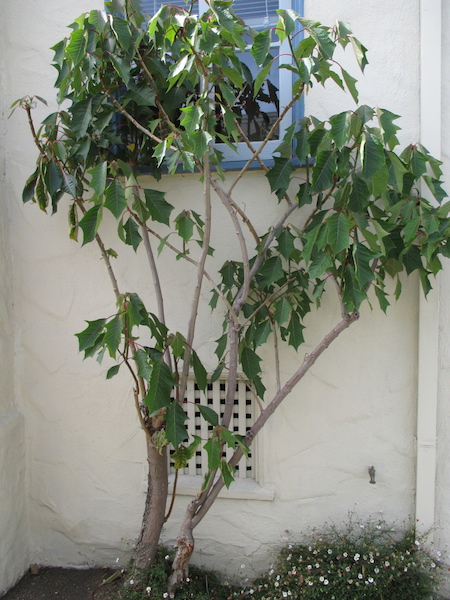
Poinsettia as a shrub (2014); photo by ALJ
|
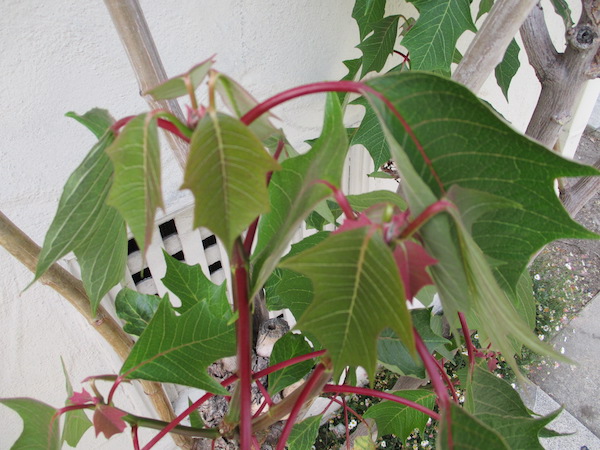
Poinsettia foliage; photo by ALJ
|
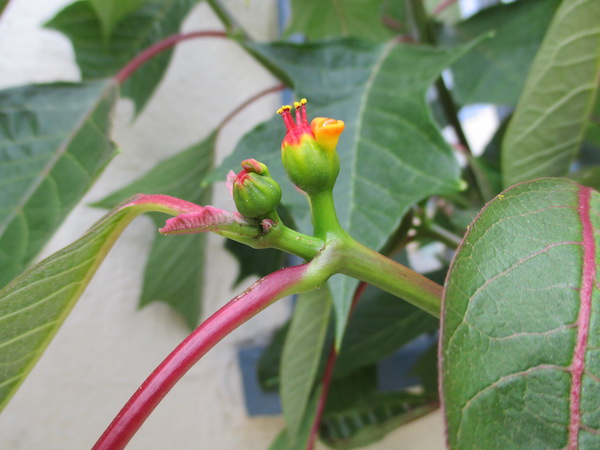
Poinsettia flowers; photo by ALJ
|

Poinsettia as a shrub (2015); photo by ALJ
|
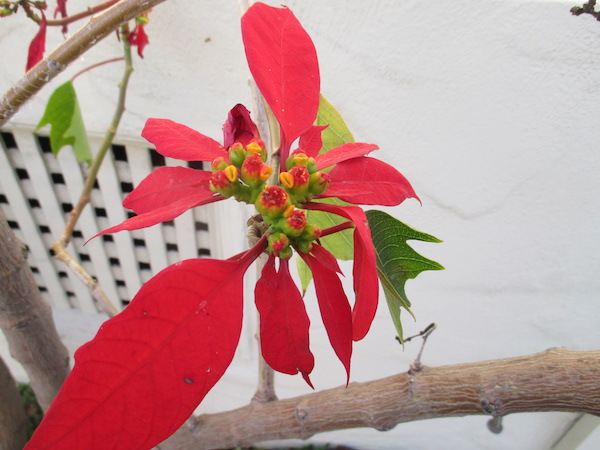
Poinsettia flowers; photo by ALJ
|
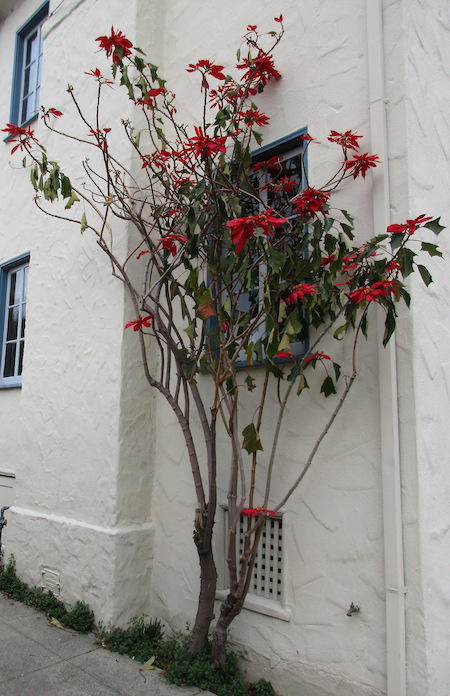
Poinsettia as a shrub (early 2018); photo by ALJ
|
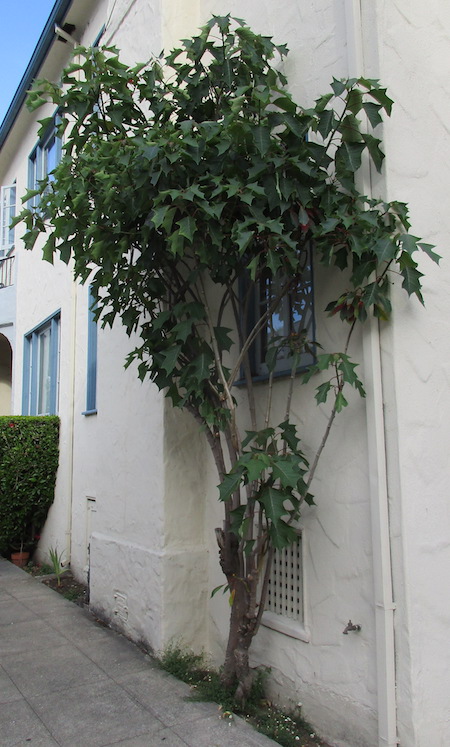
Poinsettia as a shrub (September 2018); photo by ALJ
|

